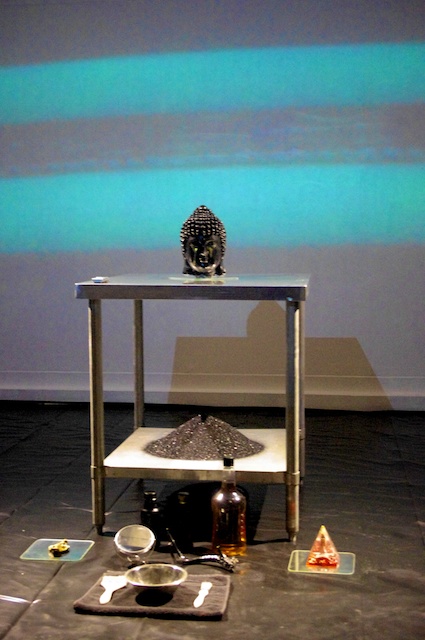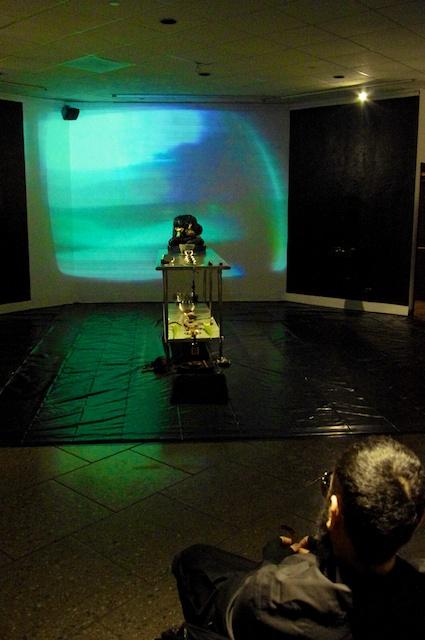Vela Phelan’s performance piece, “The Shadow Initiation Spell”, is too über-cool to describe without a smile and a little irony. However, you would agree if you could see the exhibit, currently residing in the Harbor Art Gallery, that it’s unique.
“It’s more minimalist than he usually does,” the artist’s wife said.
Vela Phelan, a part-time DJ, merges abstract and earthy, religious and atheistic elements to create a jarring aesthetic for his performance art. The Shadow Initiation Spell is a dynamic exhibit in a boxy back room with black construction trash bags taped together to carpet the floor.
A sterile steel table, the type you might find in a kitchen or a butcher shop, stands in the center of one room with the decapitated head of the Buddha. A turntable, with a black dented bat fastened above it, plays ambient sounds and shrieks to static projected onto the far white wall. The two sidewalls are painted black. Opposite, a bulging trash bag hangs over several suitcases.
Phelan sits in a black fold-up chair in the other room. He wears all black and his black beard shows patches of yellowish white along the edges. Behind him there’s a statue of an owl and several yards in front of him stands another steel table. At the far end, a black headless Buddha holds a golden baby.
“The piece is about opposites,” Phelan said. “Black and white, Buddha and baby Jesus, North and South, East and West. In a romantic point of view, my effort is to mutate it all into one.”
Diego Gomez-Aristizabal, student curator of the Harbor Art Gallery, organized the exhibit.
“People got in the mood of the music and everything going on and submerged into the experience,” he said. “It’s something that people are not too familiar with as you can tell from the reactions when they peeked through the door.”
The performance began as Phelan stood and bent forward slowly, and back, and forward again. He grabbed a can of spray paint, shook it extensively and painted over his foot, creating a track outlined in black on the cement floor between his chair and the black plastic. He did this repeatedly until he reached a rug set before the table, covered in steel bowls. Then he slowly painted his face black.
“I could have done without him walking around the table all those times,” said Kat, who stepped out of the show after about an hour. “If I’d never seen this, I would be the same person as having seen it.”
The artist continued, unabashed by the voyeurs peeping in and walking through, whispering things like, “this is demonic,” to their companions before leaving.
Phelan has a small but committed following, and he hugged almost everyone that stayed through the entire performance. Maggie Cavallo left with eyes alight, saying, “Anyone that can hold onto my attention for three hours is pretty impressive.”
For the uninitiated, this art form might be a bit disconcerting, and that’s what he was attempting. He merges sound and smell with visual elements including video, which he deemed important because he used a UHF signal, “a kind of flicker and noise that now doesn’t exist. It’s [like] the classic poltergeist, this transmission that has noise.”
Eight years ago, Phelan recorded a religious commercial for 1-800-4-prayer. You can see the words “For Prayer” flickering behind the projected static.
“It’s technically a phone number for you to call to pray to,” he laughed. “I called back in the day when I first captured that video,” he said. “It just rang and rang.”
Not many UMass Boston students stayed through the entire performance. Most stuck their head in the door, sighed and left. But the exhibit moved those who stayed. Abel Cano, the head of Casa Latina, left with a giddy grin on his face.
“I just came back from Thailand, so I was surprised to see a Buddha on the flier,” he said. “He played a track from a Cuban Palo song that I recognized. It reminded me of things I’ve read about, Santeria and Voodoo.”
The exhibit offers an eclectic mix of religious ceremony and minimalist artwork.
“There’s a structure, and the structure can be broken,” Phelan said. “But the structure guides me to that unknownness that I consider being in the middle.”
You can see what’s left if you visit the exhibit soon. The show will progress over the next few weeks as an extended improvisation, with the next segment starting at noon on Feb. 5.
“Timing is important and it’s completely random,” Phelan said. “The more I get in the middle, the more well-timed I get.”
This art inhabits the shared experience that dissolves as the artist and his audience stream off on their various tangents, several hours richer, or poorer perhaps, with an irreplaceable experience.






















































